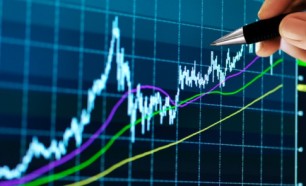Wall Street stocks were mostly lower on Friday, pulled down by disappointing economic data, but the market posted its best third quarter since 2010 after a recent wave of central bank actions set off a recovery in equities in the last few months.
Despite Friday’s losses, the Standard & Poor’s 500-stock index advanced 5.8 percent over the last three months, mainly on expectations that central banks around the world would take steps to stimulate their economies. That brought the benchmark index’s advance so far this year to 14.6 percent.
For the third quarter, the Dow Jones industrial average rose 4.3 percent and the Nasdaq composite index 6.2 percent.
On Friday, investors grappled with disappointing economic data on the United States economy. The Institute for Supply Management-Chicago’s index of Midwest business activity showed contraction for the first time since 2009, falling to 49.7 in September from 53.0 in August.
The data follows other weak regional manufacturing reports and a sharp drop in durable goods orders last month.
On Friday, the Dow fell 48.84 points, or 0.36 percent, to 13,437.13. The S.& P. 500 fell 6.48 points, or 0.45 percent, to 1,440.67, and Nasdaq fell 20.37 points, or 0.65 percent, to 3,116.23.
Reflecting the defensive tone, nine of the 10 S.& P. sectors fell. Only the utilities index was positive, up just 0.4 percent. European stocks dropped sharply Friday, with the Euro Stoxx 50 of euro zone blue chips declining 2.1 percent. Madrid’s IBEX 35 was down 1.7 percent, as the early lift from Spain’s new round of spending cuts, which had also bolstered Asian markets overnight, collapsed.
“On this last day of the quarter, the focus remains on the situation in Europe, which is causing nervousness,” said Peter Cardillo, chief market economist at Rockwell Global Capital in New York.
The euro fell against the dollar, closing out a second straight week of declines, as uncertainty persisted about Spain’s bailout prospects.
An independent audit from the consulting firm Oliver Wyman released on Friday showed that Spain’s banking industry would need 59.3 billion euros, or $76.5 billion, in additional capital to cope with a serious economic downturn. Spain, however, said it would ask for only $51.6 billion in European aid for its banks.
European governments have allotted a $129 billion credit line for Spain’s banking sector.
The audit report was viewed as positive because the final figure on the country’s banking capital needs was largely in line with market expectations, removing another layer of uncertainty.
The euro did trim losses versus the dollar after the news on the bank audit report, but the general stance on the common currency remained cautious.
Recent protests against austerity plans in Greece and Spain have also heightened investors’ concerns as the turmoil could impede political maneuvering. However, stocks were off their lows of the day after Spanish bank stress tests were mostly within expectations.
“We had been seeing good data recently, but now we seem to be following the slowdown in China and Europe and we’re seeing weakness,” said Paul Nolte, managing director at Dearborn Partners in Chicago.
Interest rates were lower. The Treasury’s benchmark 10-year note rose 7/32, to 99 30/32, and the yield fell to 1.63 percent from 1.66 percent late Thursday.
[This article was originally published by REUTERS on September 28, 2012.]

